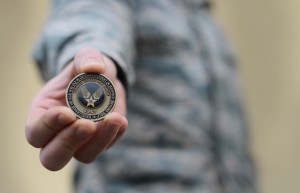
The Airman’s coin signifies the beginning of an enlisted member’s career upon graduating basic military training. The original version of the Airman’s coin featured an eagle clawing its way out of the coin with the words “Aerospace Power” under it. The most recent coin replaced the eagle with the new Air Force symbol.
AVIANO AIR BASE, Italy — Throughout the time we spend in the military, we collect many things. Whether they are mementos, awards or habits, such items are kept to remember the special moments we never wish to forget. Challenge coins are an example of these memories, as they are a form of recognition of the hard work and excellence an individual has displayed.
Whether the coins are presented by the president, a chief master sergeant or a first sergeant, their value is determined by each individual. However, the true history of the challenge coin dates back to World War I, when an American pilot was shot down and captured in Germany.
While escaping from the grasp of the Germans, the pilot made his way to France, where they believed he was a spy and sentenced him to be executed. To prove his identity and save his life, he revealed a bronze medallion with his flying squadron’s emblem, confirming that he was an American pilot. The French spared his life and celebrated by giving him a bottle of wine instead.
After this incident, it became a tradition that all members of the squadron carry their medallion, sparking challenge coins to become a trademark for military tradition and pride.
One of the sought-after coins for Air Force enlisted is the Airman’s coin. After the long weeks in basic military training, the Airman’s coin ceremony officially marks the transition from a trainee to an Airman.
“When I received my first coins for graduating both basic training and financial services apprentice school, it meant I was a part of something,” said Lt. Col. Michelle Libbey, the 31st Comptroller Squadron commander.
“Receiving a coin is a sense of pride and a form of identification,” Libbey said. She was enlisted in 1996 and later commissioned in 2001.
While most service members proudly display their coins for others to see, others choose to always carry their most important coin in their pocket in the event of a coin check.
“Although coins have become less popular from when I joined the military, I still carry a coin in my pocket when I go to official functions,” Libbey said. “Because if you do not have one, and someone else performs a coin check, you are responsible for buying everyone a round of refreshing beverages and that can get expensive.”
The tradition of coin checking also began in Germany after World War I. American personnel who were stationed in Germany adopted the local ritual of “Pfennig” checks.
A Pfennig was the lowest denomination of German currency. If a service member did not have a Pfennig, they would have to buy the next round of drinks. This ritual carried over and became part of the challenge coin tradition.
Though the legacy of coin checking typically stayed within the enlisted ranks, Libbey explained how officers have their own traditions with challenge coins.
Known as a “first salute” coin or a “silver dollar” salute, a coin was presented to the first enlisted member who saluted the newly commissioned officer. The 19th century phrase that encompassed this action was, “you have to buy your first salute and then earn every salute thereafter, through your performance and by gaining respect of your subordinates.” This is to honor the enlisted personnel who help officers achieve their commission status.
“When I became a commander, creating a coin was one of the first things I wanted to do,” Libbey said. “You want to have something that signifies excellence and to recognize the Airmen who are bringing more than average to the mission.”
The challenge coin tradition that began in World War I exhibits commendable service, a lively legacy and supports unit morale across the Air Force. Although all coins are different, they all tell a story for each recipient and give a personal touch on recognition.
“The tradition definitely started in the enlisted ranks, but they are no less important to me as an officer,” Libbey said. “When I look at my coins, they are like a tapestry to me. They paint a picture of where I have been throughout the past 19 years and they represent the incredible people I have met.”


